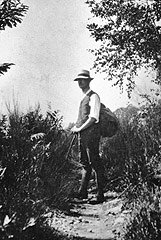 |
 |
Hermann Hesse liked to walk. It was only in the last years of his life that his wife Ninon drove him around. That is why Hesse has been often called «the endless walker». In his research, he was ready to go beyond the limits, not only from the physical point of view. Hermann Hesse experienced the pleasure of walking and the joy of discovery wandering about through unknown places, in particular in Italy, during the journeys between 1901 and 1914, sometimes alone, sometimes with Othmar Schoeck, Fritz Brun, Fritz Widmann and Mia Bernoulli. Away from the usual itineraries, he discovered Northern Italy, Tuscany and Umbria. After 1919, Ticino offered him this pleasure, which he described in his book Wanderung [The Wayfarer]. Starting from Montagnola, Hesse used to explore the southern part of Ticino, and the Italian regions nearby. He often took his easel, his palette and a stool and transformed his impressions into sketches and watercolours.
«Our longing for wandering and for a roaming life is mostly love, eroticism. Half of the romantic side of travelling is nothing else than waiting for the adventure. But for the other half it is an unconscious impulse to change and dissolve the erotic element. We wayfarers are used to cultivating amorous desires because of their unsatisfiability, and we dispel that love, which would belong to the woman, lavishing it to the village and to the mountain, to the lake and the chasm, to the children on the path, to the ox on the field, to the bird and the butterfly. We free love from the object, love alone is enough for us; in the same way, we do not seek the aim in our wandering, but only the enjoyment of wandering for itself, to be on our way.»
|